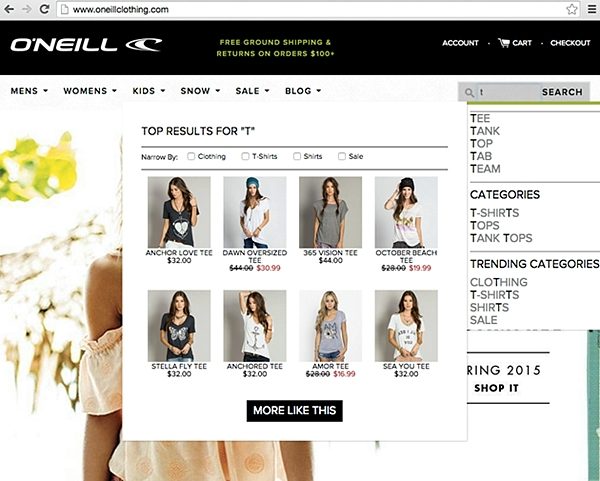When is the last time you thought about your e-commerce site's search solution? If you're like most digital retailers, you probably haven't given it much thought in years.
Site search is the workhorse of online shopping, yet it is rarely considered a critical part of an e-commerce strategy.
That's a huge mistake. Site search is the single strongest indicator of online buying intent. When customers use site search, they're likely looking to buy. If your site search isn't running optimally, you're missing sales opportunities.
Let's take a look at five things every e-commerce site should be doing with its site search.
1. Feature the Search Box
Most e-commerce sites treat their site search as an afterthought. Compared with featured-product slideshows and animated overlays and other "toys," the humble site search box can seem static and utilitarian. But it doesn't have to be.
More than most other pieces of the online shopping experience, site search allows for direct communication between the customer and the retailer. It doesn't need to be limited to that dictionary-like lookup system of the last generation of e-commerce. It can be a dynamic, intuitive, and interactive tool for directly connecting with the customer.
Instead of hiding the search box in a corner of the site navigation, A/B-test locations to find where search performs best and where it's most intuitive for your visitors.
2. Tracking Site Search Data
If you aren't tracking your site-search data, you're throwing away the most valuable first-party customer data you have:
- Are you tracking your search conversion rate, allowing you to see how often a search query results in a sale?
- Do you know your revenue per search, allowing you to see just how much every search query is worth?
- Are you even tracking your overall search usage, allowing you to see what percentage of shoppers use your site search to find items?
Those are vital details for any e-commerce team to track, yet many retailers completely overlook them. By tracking those data points, you have the ability to create real benchmarks.
If you aren't measuring something, it's impossible to know how to improve it.
3. Intuitive Customer Expression and Smart Search Suggestions
Is your site search smart enough to recognize "pants," "slacks," and "trousers" as the same kind of product? Can it recognize spelling mistakes and auto-suggest alternatives in real time? Can it dynamically create such connections, rather than rely on constant manual updates from programmers?
The smarter your site search, the more likely it is to result in conversions.
People are pretty good at making connections between similar concepts, overlooking obvious mistakes, and filtering out obviously irrelevant details and results; unfortunately, those are also things that most computer programs are terrible at. In other words, your site search results are only as good as their programming.
4. A Picture Is Worth A Thousand Words
What is a more compelling response to a shopper who is searching your site and types in the letters "s", "h," and "o"? Autofill that simply suggests "shorts," or real time visuals that show actual product imagery matching users' gender and style preferences while they type?
Embedded images that appear as a user types a search query tell a much more powerful story than simple text ever could. What was once a dictionary-like lookup tool can now be a powerful merchandising opportunity to instantly place individually relevant products directly in front of a consumer's eyes.
For examples, check out our customers' sties: www.disneystore.com or www.oneillclothing.com.
5. Personalize Results for Mobile Shoppers
One of the greatest frustrations for mobile shoppers is wading through a site search system that isn't optimized for the smaller screens and touch-based interfaces of today's smartphones and tablets. Search results on mobile platforms tend to be excessively long reels of results, laborious to review and often irrelevant to the shopper's actual interests or needs.
By making use of intelligent preferences and observations about the shopper, you can deliver results that are prioritized for their individual interests so that the most relevant and preferred items are listed first. There is no need for endless swiping and scrolling to find the right items, because those items are always at the top of the list.
Even the limitations of smaller screens become minimized when the most relevant results are presented first.
As an e-Commerce Retailer, You Can't Afford to Overlook Site Search
Today's digital shoppers expect to be able to find the right product easily, yet most e-commerce sites use outdated site search tools that consistently under-deliver on that expectation. Customers are increasingly impatient at having to make multiple searches, browse endless results, or stumble through site navigation to find the right thing.
Retailers that implement new site search options built around providing better-personalized and visual results see double-digit gains in conversion rates and revenue. In other words, the easier you make it for your customers to shop with you, better it is for your bottom line.





